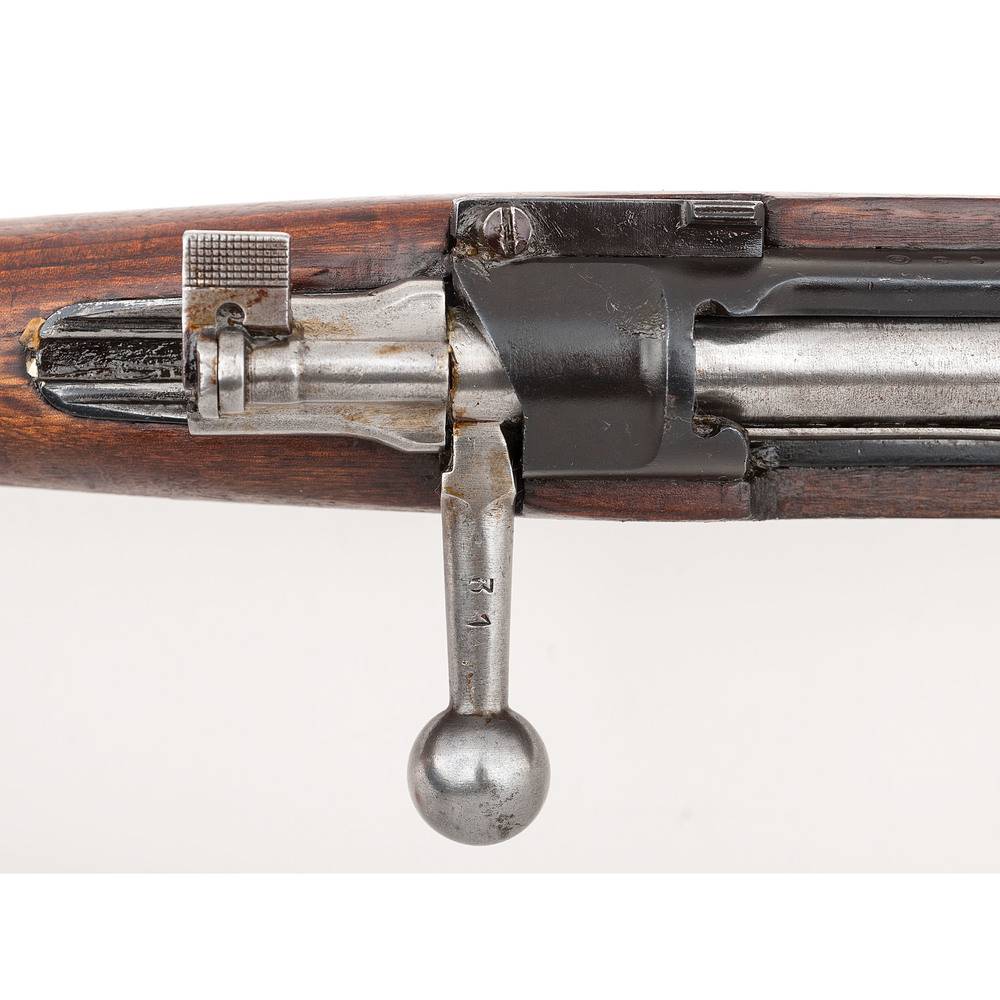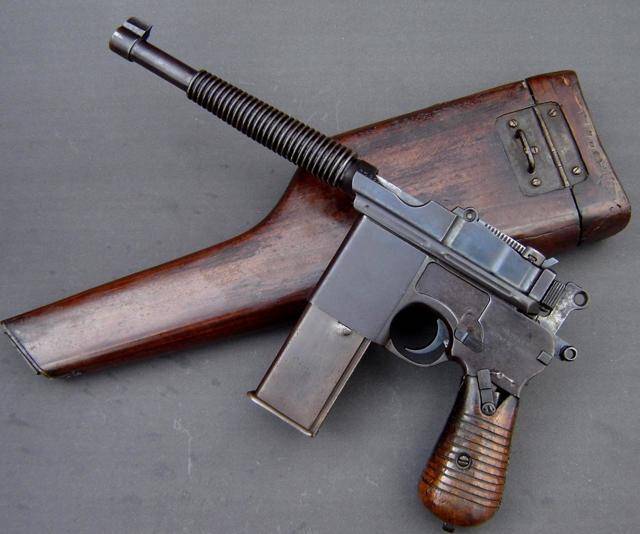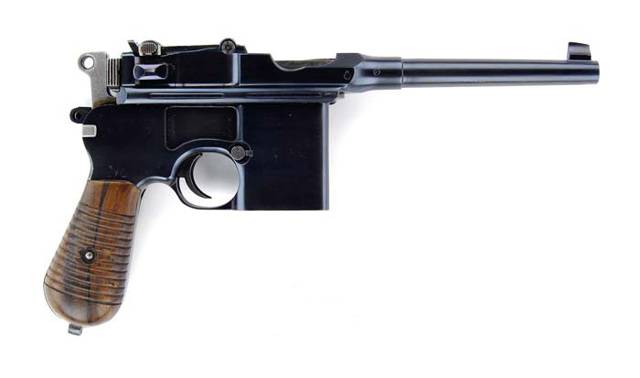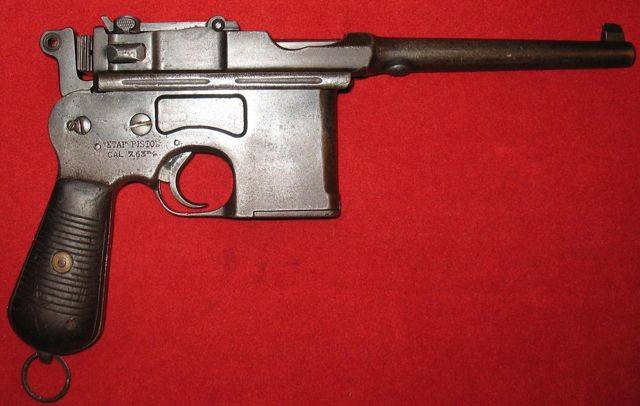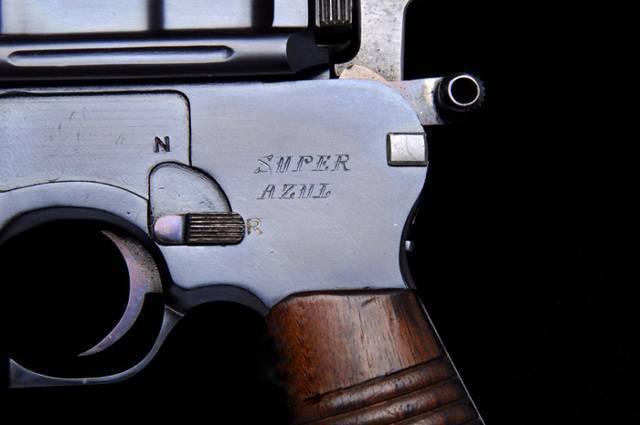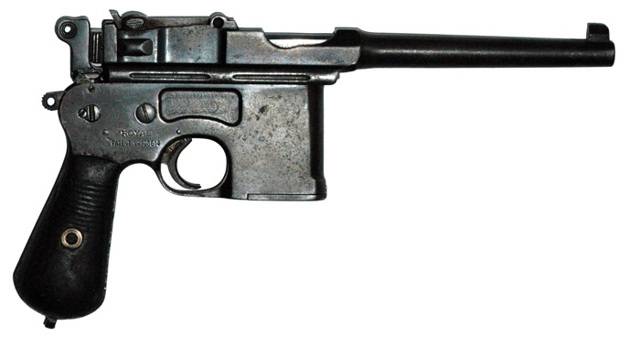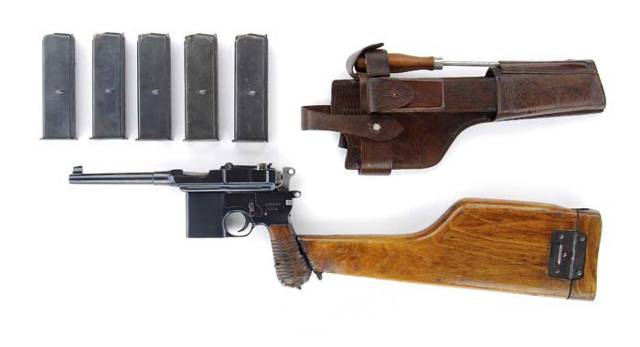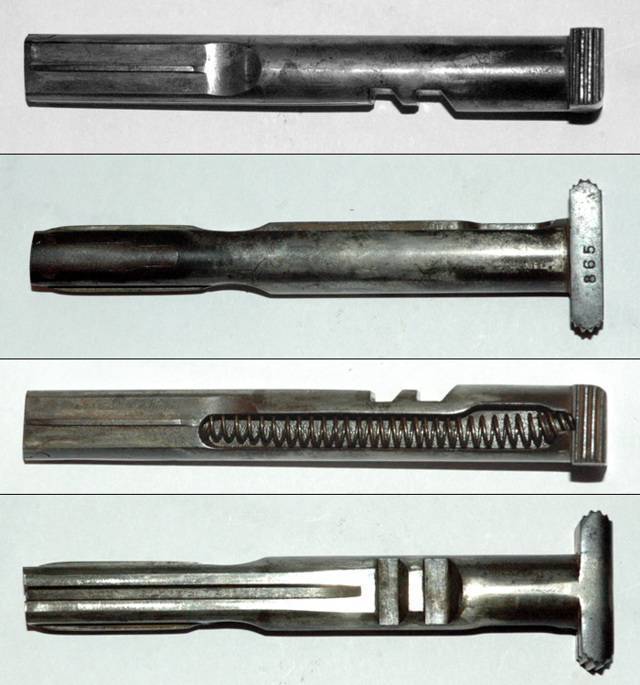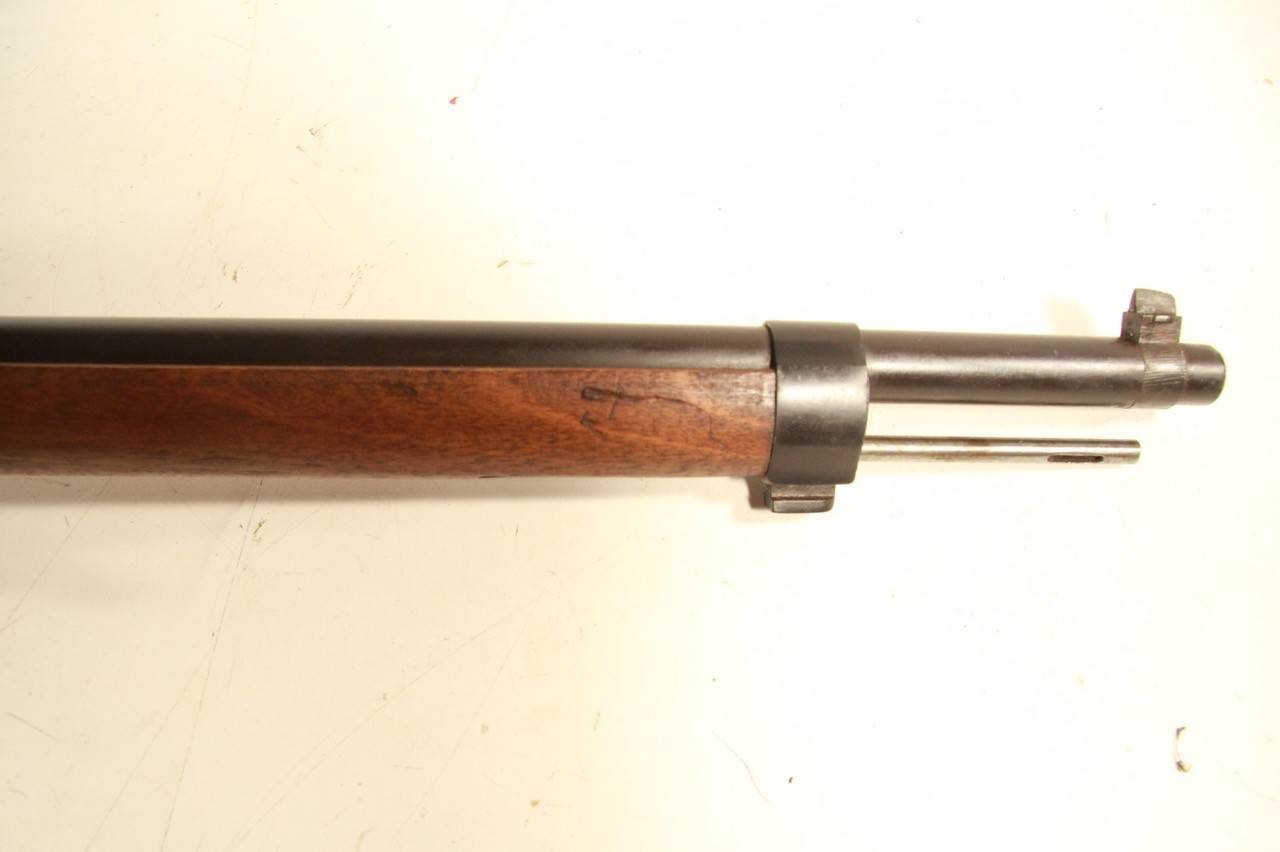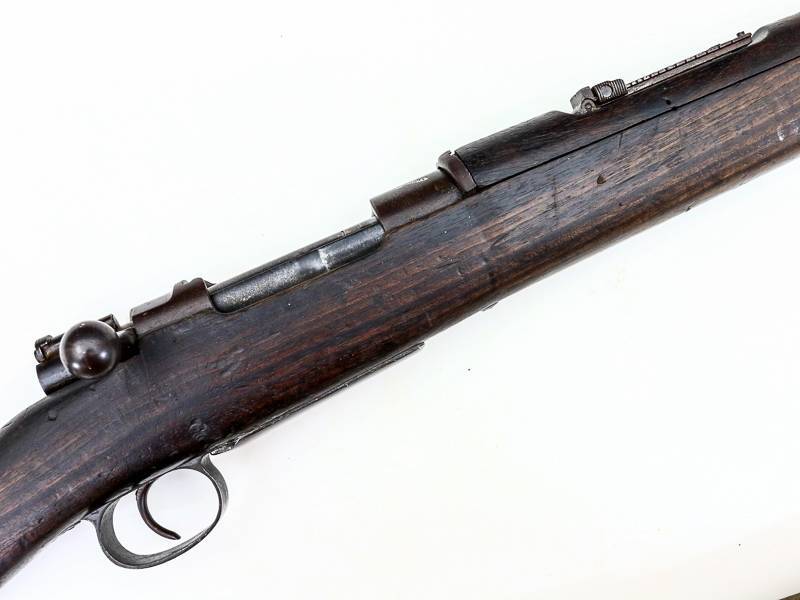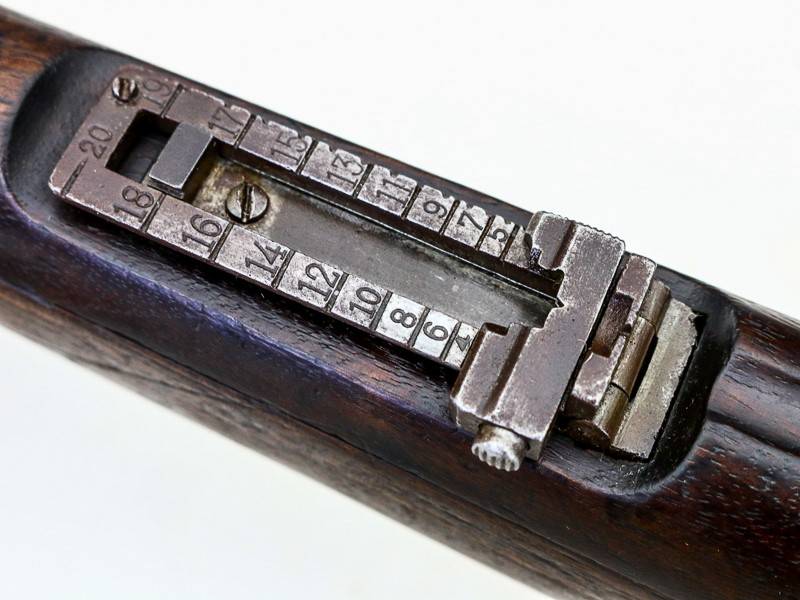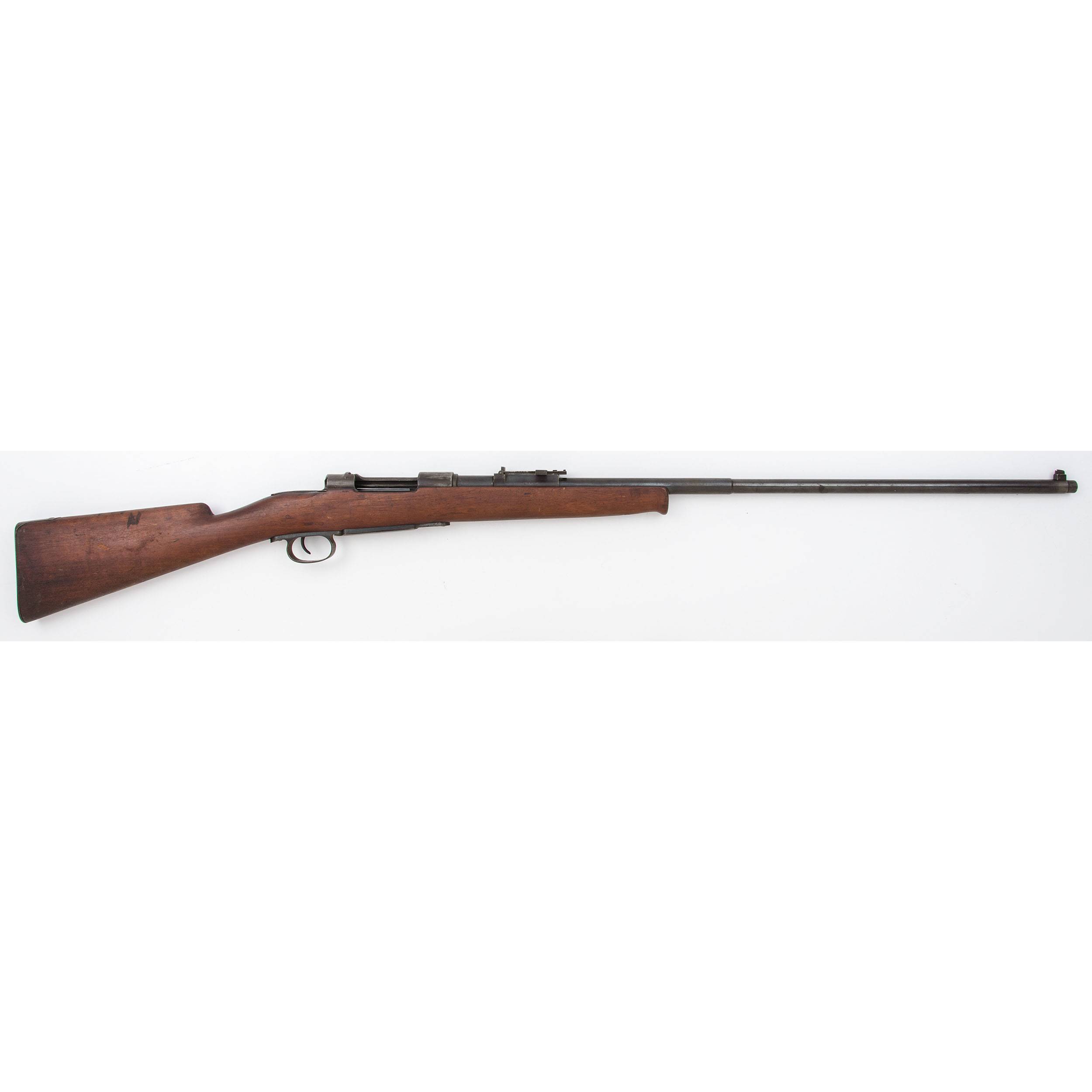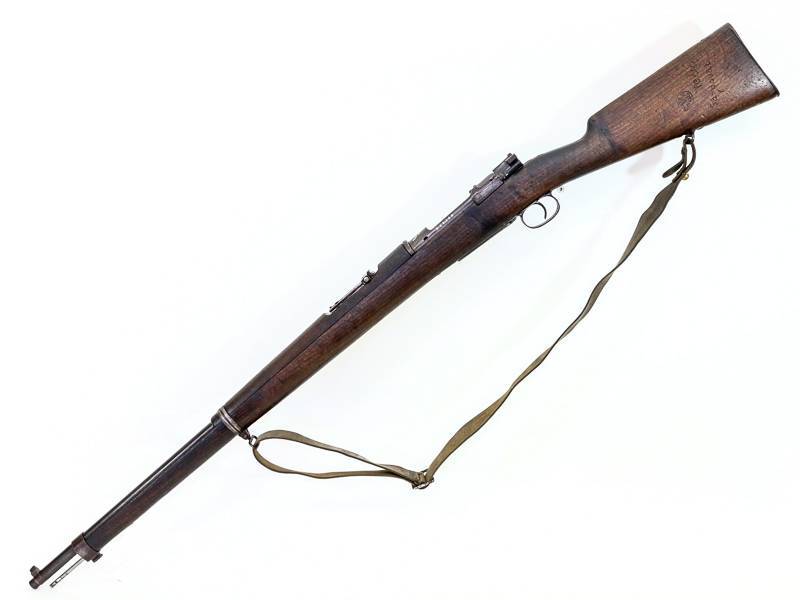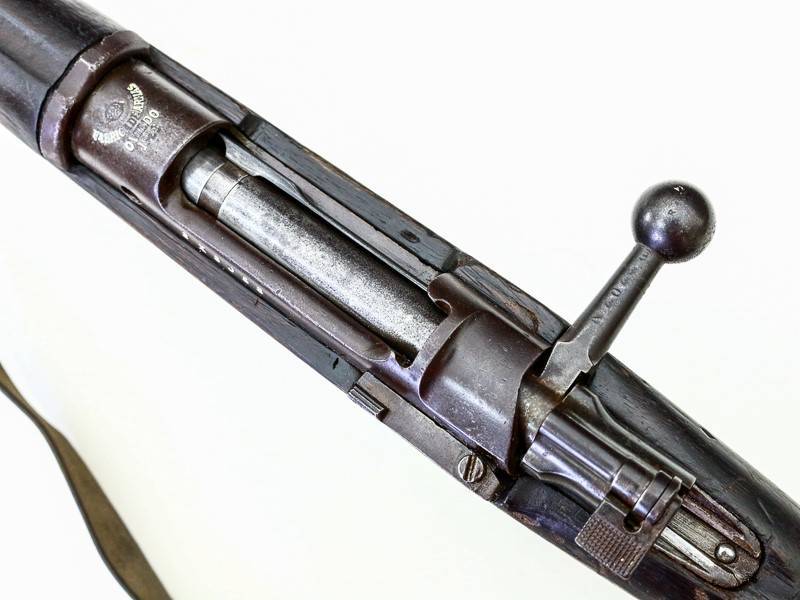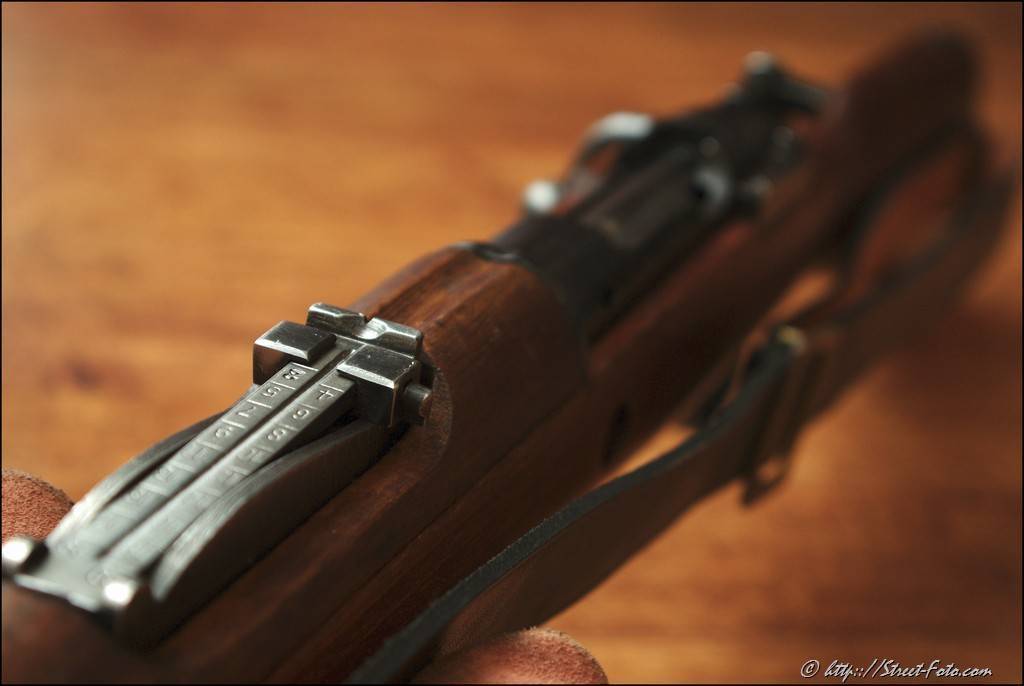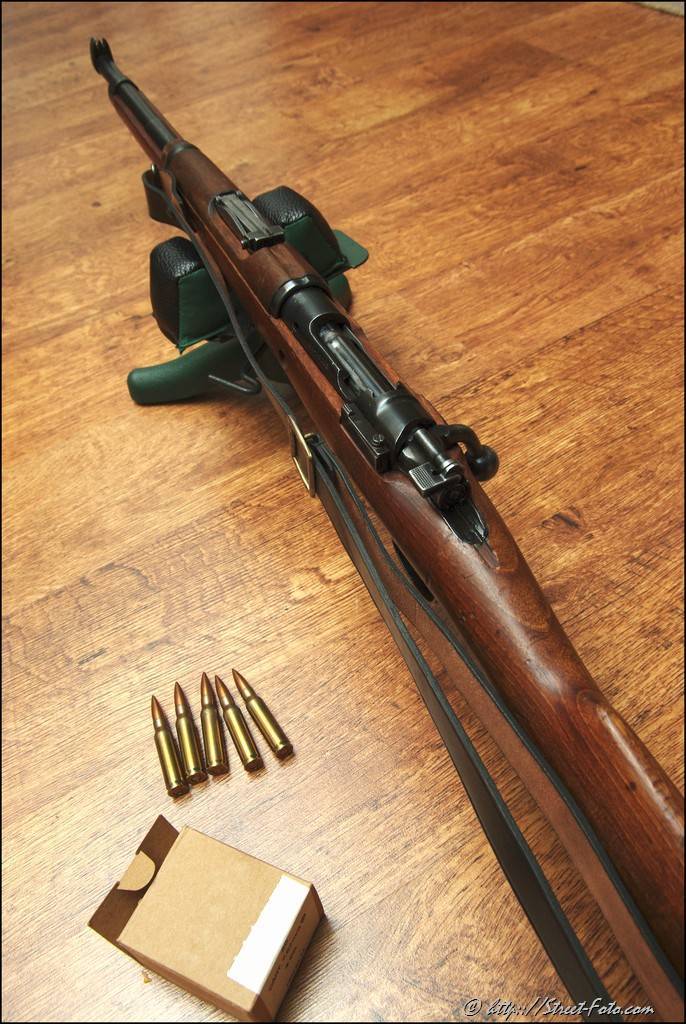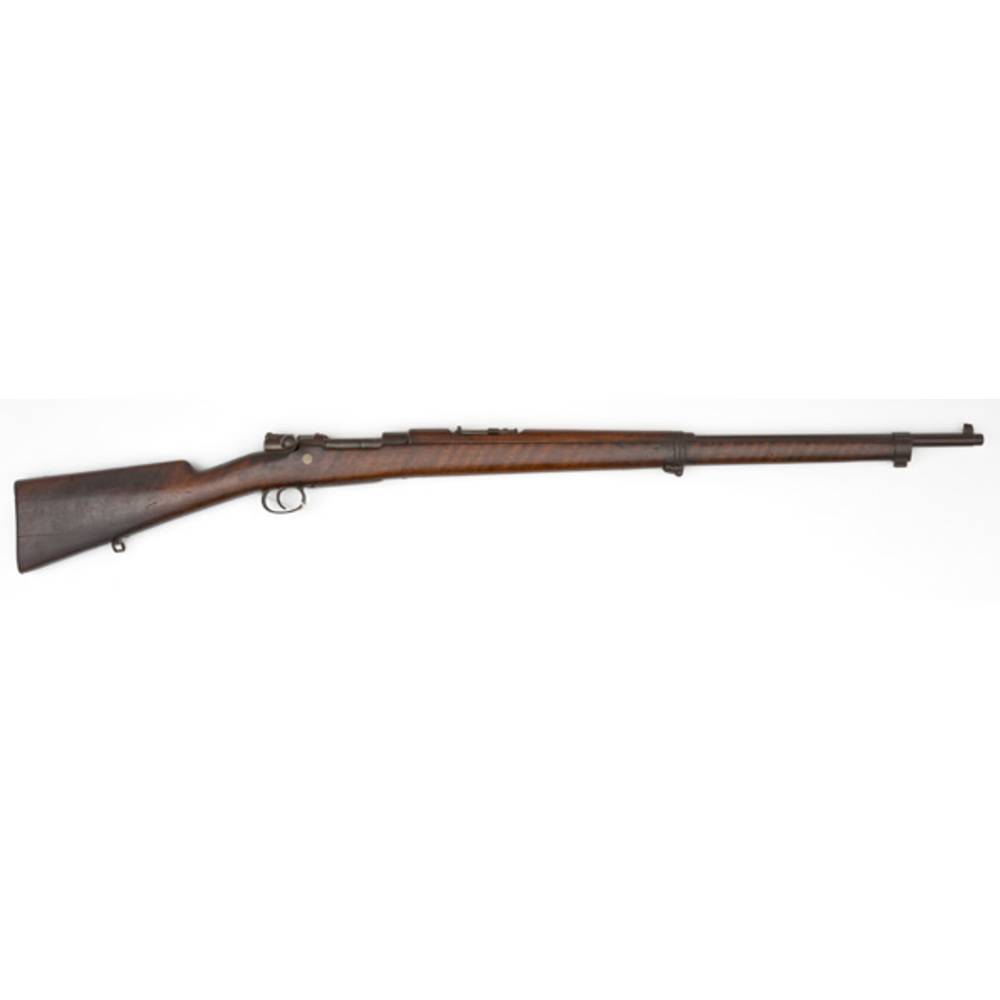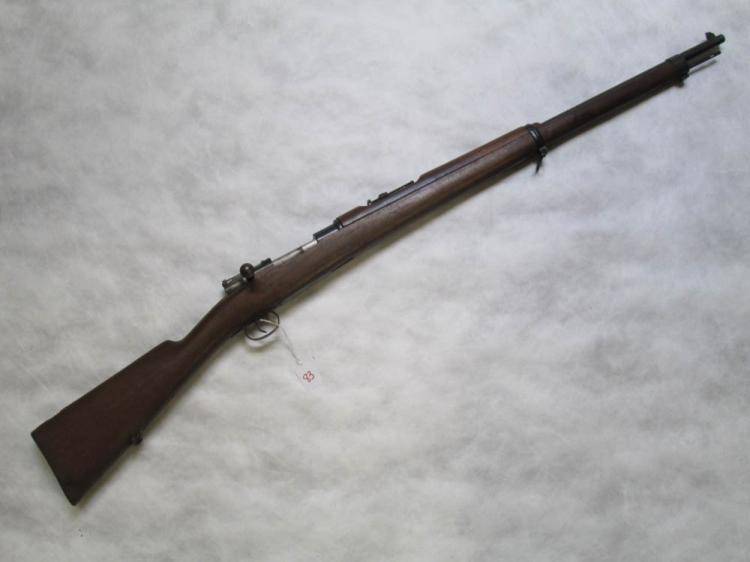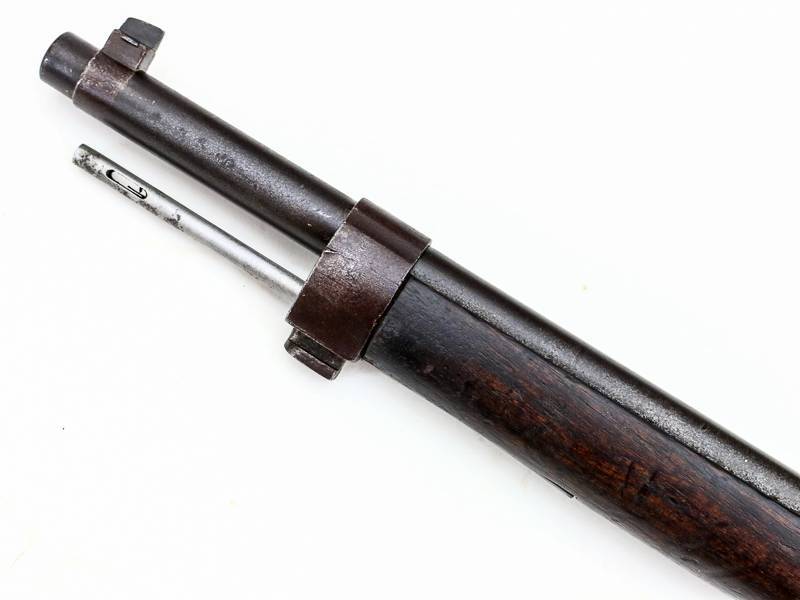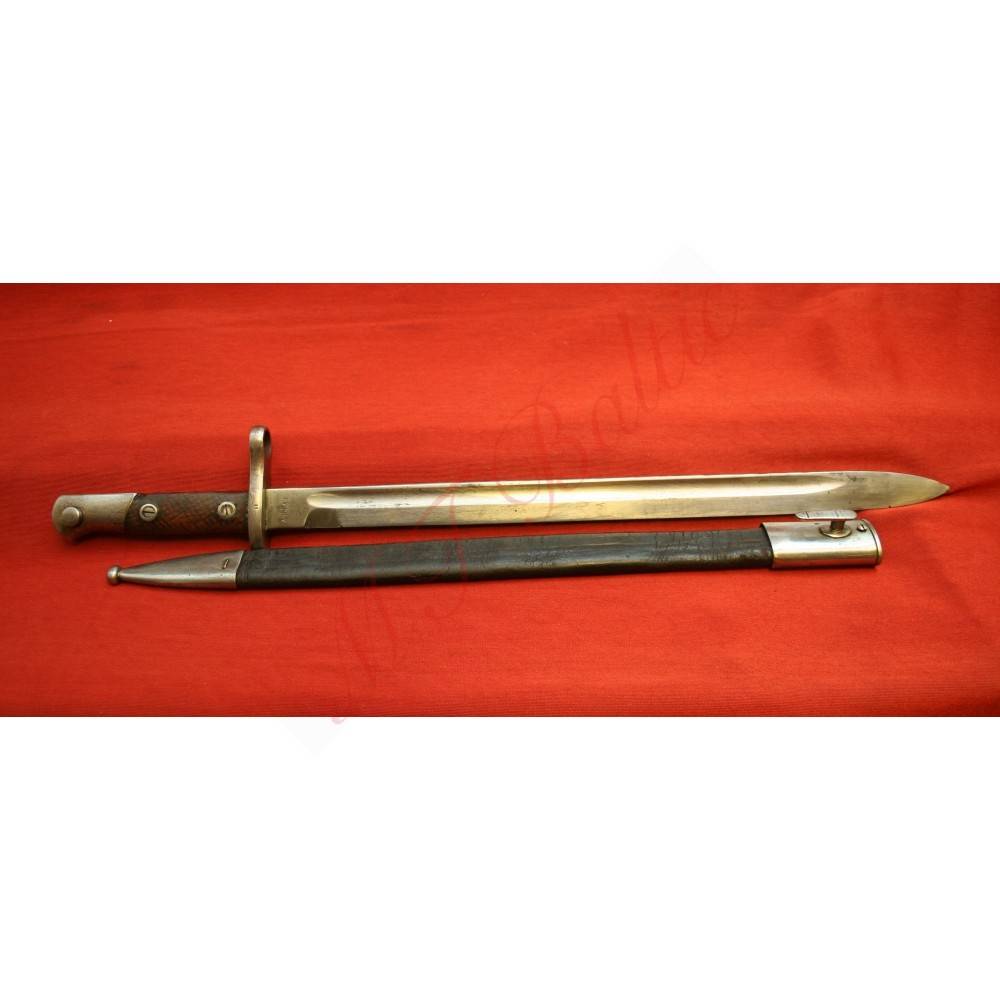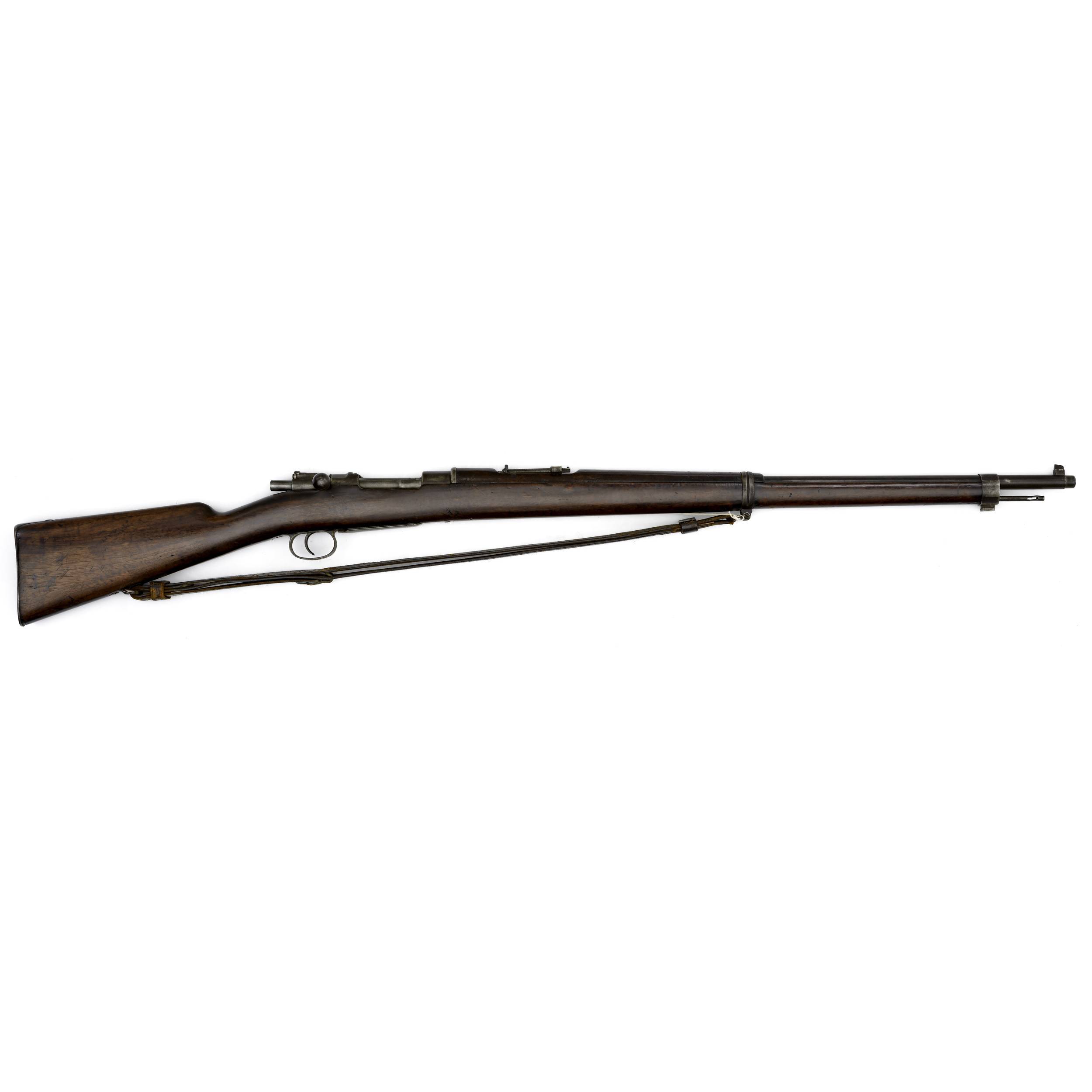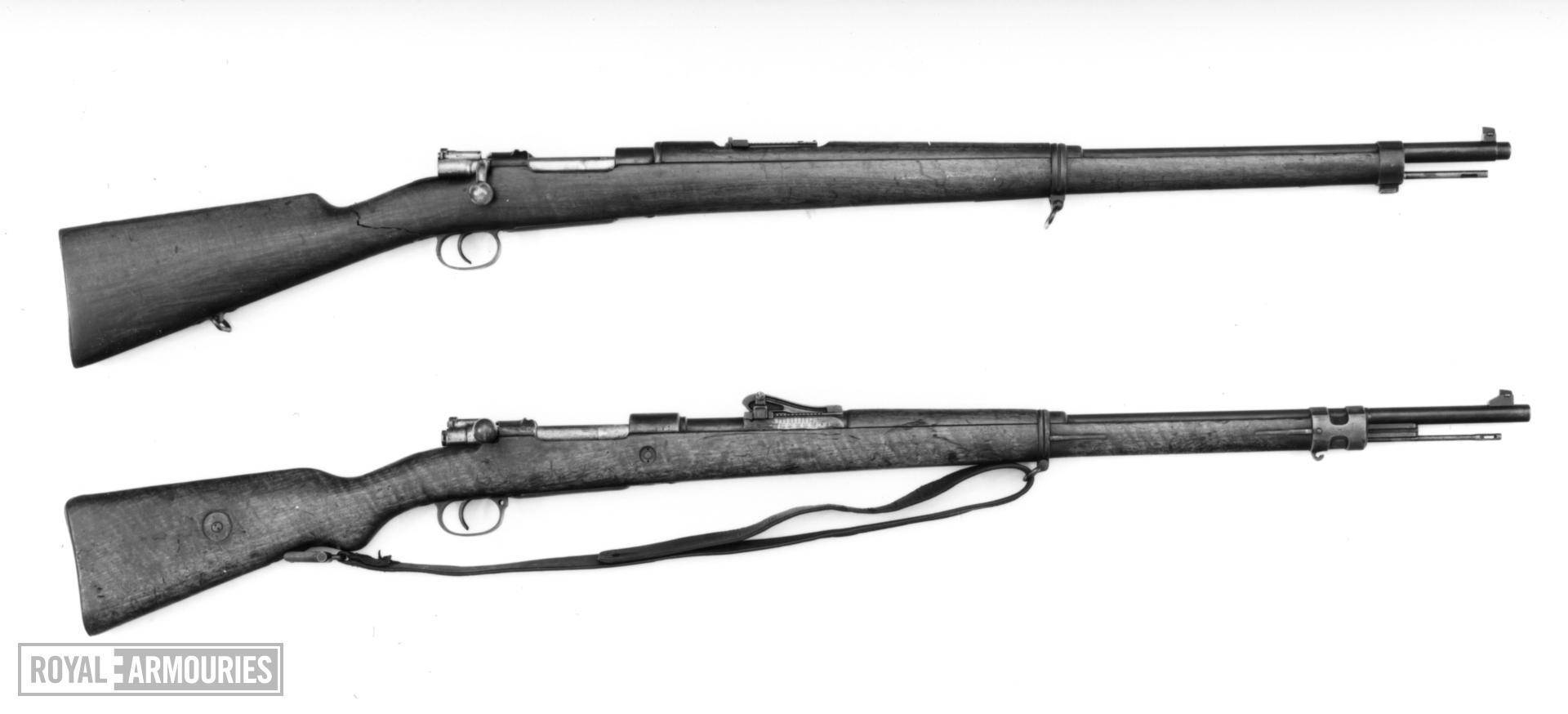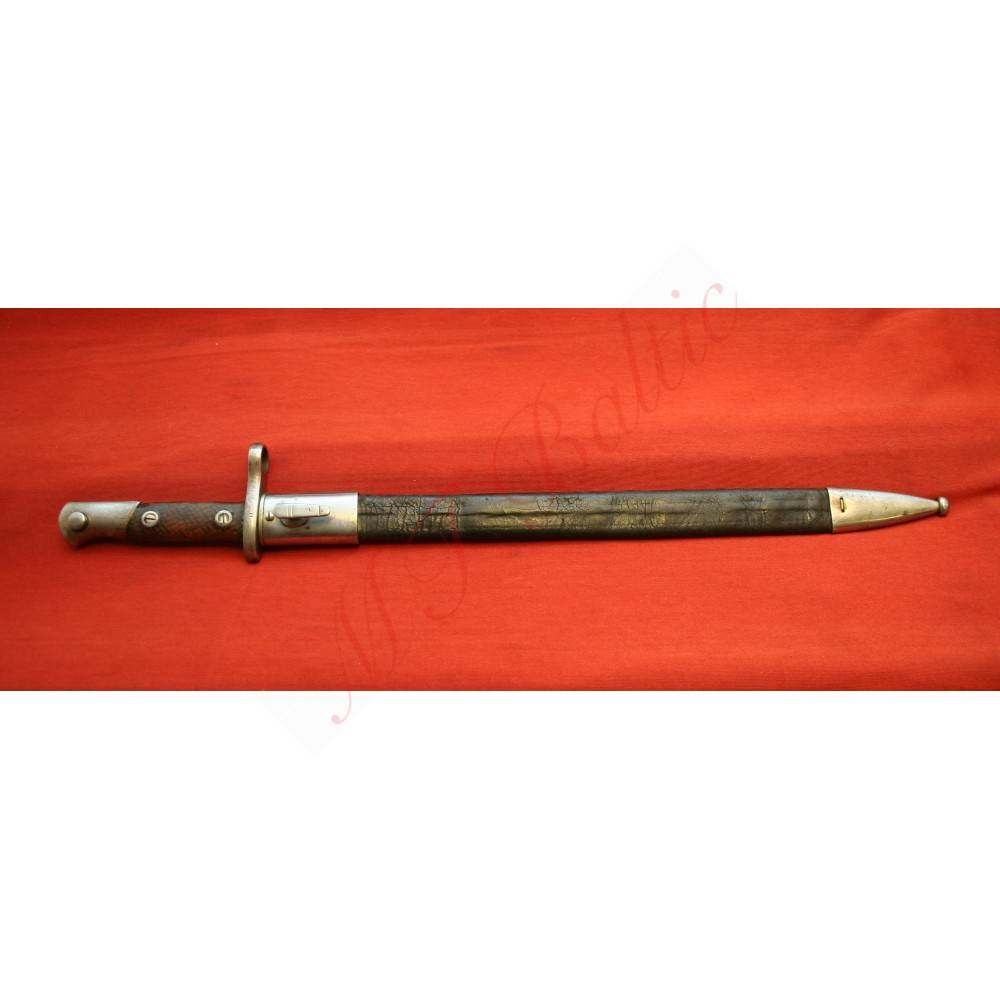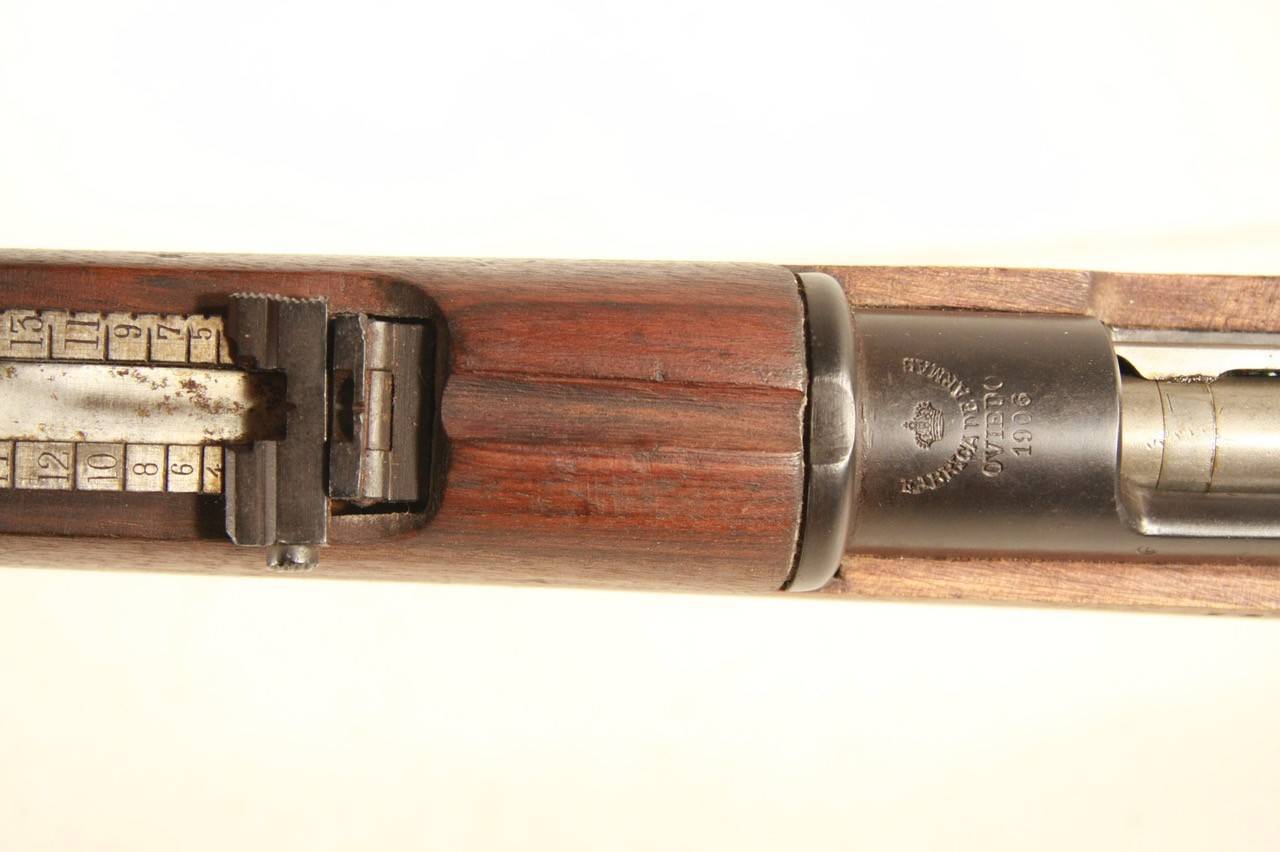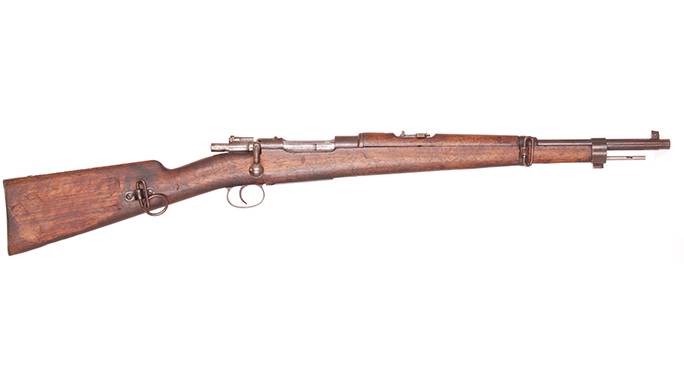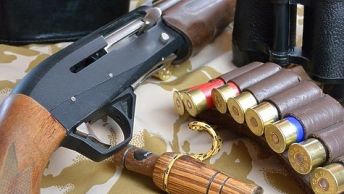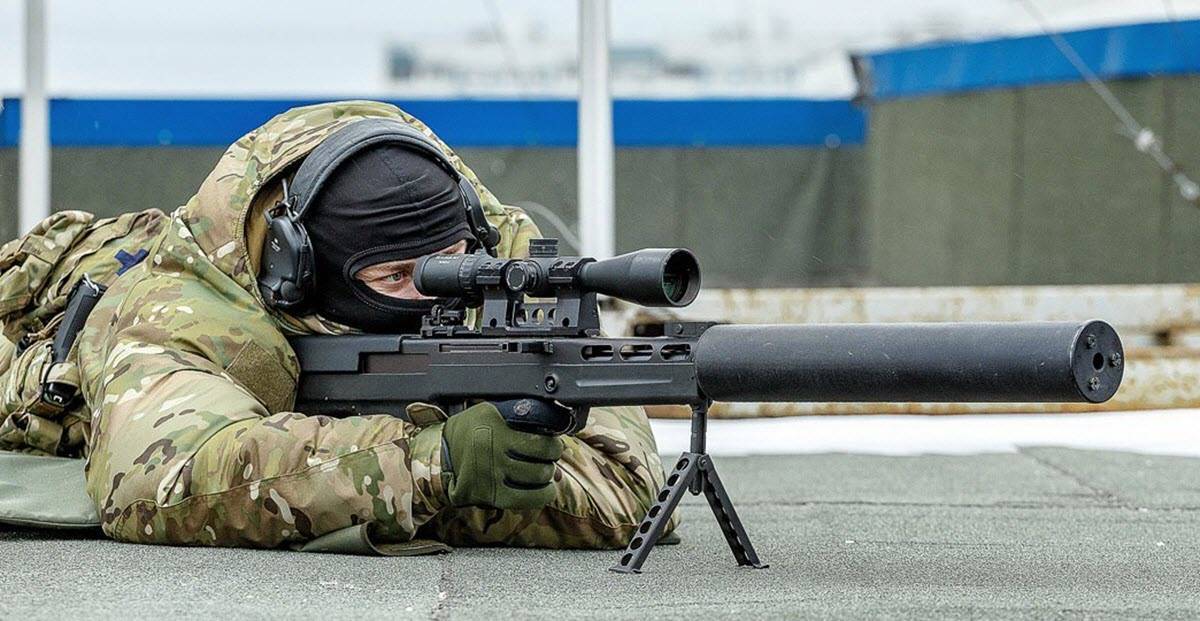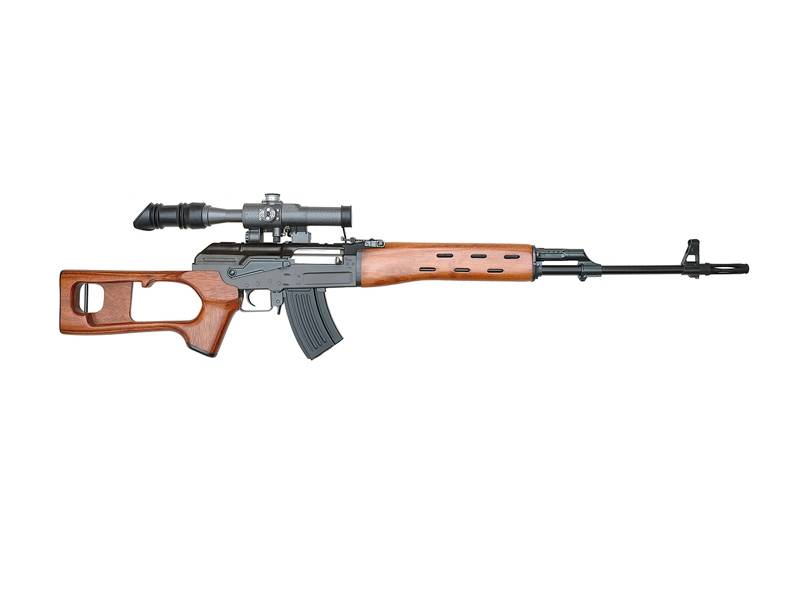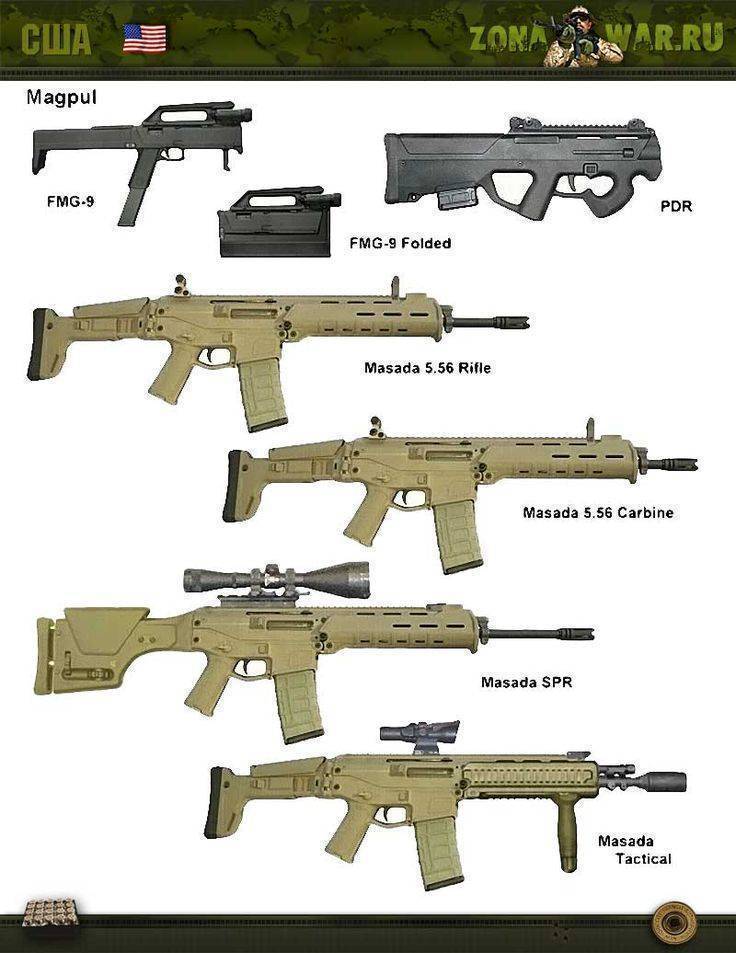Variants
Ottoman variant
An Ottoman Mauser 1893, captured during the World War I and exposed in the Auckland Museum.
When the Ottoman Army learned about the new Spanish model of 1893, it ordered some 200,000 rifles in the same configuration. Their rifles were chambered for the 7.65×53mm Argentine cartridge and were identical to the Spanish model, except for a , which when engaged permitted the feeding and extraction of single cartridges only while keeping the cartridges in the magazine in reserve, and a cylindrical bolt. The bayonet lug fit the M1890 Bayonet, which the Ottomans had already acquired in large numbers. Most of these rifles still in Turkish hands were later re-barreled and converted to fire the far more common and powerful 7.92×57mm Mauser after the Turkish Army adopted that caliber.
Spanish Model 1895 carbine
1893–1895 Mauser rear sights
The Spanish Army adopted the Model 1895 carbine on 7 May 1895; the rifle was essentially a shortened M1893, with a full-length stock that ran to the muzzle. Though the carbine bears the 1895 designation, it did not include the improvements made in the M1895, and was essentially just a shortened M1893. It received the 1895 designation as the Spanish Army did not approve the carbine for service until that year. Ludwig Loewe manufactured around 22,500 of the M1895 carbines between 1896 and 1897 before licensing production to Fábrica de Armas, which built an unknown number of the rifles between 1898 and 1915, when production changed over to the Model 1916 short rifle.
The carbine had an overall length of 37.4 inches (950 mm), with a 17.55-inch (446 mm) barrel and a stock that extended to the end of the barrel. The carbine weighed 7 to 7.5 pounds (3.2 to 3.4 kg) empty. The M1895 carbine also differed in some minor details, including the rear sight, which was graduated only to 1,400 meters (4,600 ft), and the bolt handle, which was turned down. Since the carbine was intended to be used by cavalry, it used a single, large lanyard loop on the bottom of the wrist instead of traditional sling loops. In 1896, the design was modified slightly, to add a sling ring to the barrel band and a sling bracket in the left side of the butt. Unlike on the longer rifles, the upper barrel band did not include a bayonet lug. The left side of the rear of the receiver was cut down to facilitate the use of stripper clips.
Spanish Model 1913 short rifle
The Model 1913 short rifle was an experimental development to replace the M1895, though it was identical to the M1895 in most respects. The short rifle was slightly shorter than the carbine, at 37.2 in (940 mm) overall, though it was slightly heavier, at 7.12 pounds (3.23 kg) empty. It retained the same length barrel and the same action, but unlike the M1895, the forward barrel band incorporated a bayonet lug for the M1893 sword bayonet. The rifle was issued in small numbers for field trials beginning in 1914, but they were soon superseded by the Model 1916 short rifle. Surviving M1913s were issued to buglers in cavalry squadrons beginning on 2 April 1918.
Spanish Model 1916 short rifle
The Model 1916 rifle was adopted on 14 November 1916 to replace the M1895 carbine, the short barrels of which were not optimized to take advantage of the higher velocity of the M1913 cartridge. Like the M1913, the left rear of the receiver was cut to facilitate stripper clip loading, though it was cut fully flush with the stock. Gas escape holes were added to the bolt and to the receiver to vent excess gas in the event of a case failure. Also like the M1913, the M1916 rifle had a bent bolt handle, a full-length stock with a lug for an M1913 sword bayonet. Beginning in 1913, large sight protectors were added to the front sight. These rifles featured a 21.75-inch (552 mm) barrel, though a carbine version was also manufactured with a 17.7-inch (450 mm) barrel, though this may have been an experimental version. The M1916 was manufactured by Fábrica de Armas from 1916 to 1951 and Industrias de Guerra de Cataluna from 1936 to 1939.
Starting in 1943, many of the M1916 rifles were converted to fire the larger and more powerful 7.92×57mm Mauser cartridge, which Spain had adopted that year with the M43 rifle. Some of these guns received new stocks with pistol grips and finger grooves in the fore end. In the 1950s, many of the M1893 and M1916 rifles were converted to accept the 7.62×51mm NATO round. These rifles retained their original furniture and fittings, though some were converted further to the FR7 standard, which received cut down stocks, a shorter 18.5-inch (470 mm) barrel, and more modern . Both versions of the re-barreled rifles were employed for military training and Guardia Civil use, along with the similarly converted FR8, which was based on the M43 action.
Винтовка Маузера образец 1898 года
Винтовка Маузера образца 1898 года стала наиболее массовым оружием немецкой пехоты в годы Первой мировой войны. Она отличалась качественным изготовлением, мощным патроном калибра 7,92 мм и пятизарядным магазином. Этот образец стал основой для разработки многих других моделей.
Многолетний боевой опыт не мог не повлиять на изменение экипировки и вооружения немецкого солдата. На рисунке представлен немецкий пехотинец, вооруженный укороченным карабином типа 1898К. На его голове примечательный своей формой «рогатый» стальной шлем-каска, за поясным ремнем видны специальные ножницы для перекусывания колючей проволоки.
Первой винтовкой Маузера, принятой на вооружение германской армии, стала винтовка Маузера образца 1888 года. Она имела затвор, конструкция которого осталась неизменной и по сей день, однако он сочетался с устаревшим 8-мм патроном.
В связи с новыми, более высокими требованиями после серии испытаний на вооружение был принят новый 7, 92-мм патрон с более совершенным пороховым зарядом и пулей.
Новая винтовка под этот патрон стала называться «Gewehr 1898» (винтовка образца 1898 года). Этому образцу было суждено стать одним из самых удачных и распространенных в мире оружием в своем классе.
которое выпускалось в огромных количествах.
Даже в более поздних винтовках было много заимствовании от винтовки образца 1898 года, которая стала классической маузеровской винтовкой, удобной, пусть длинноватой, но удачно сбалансированной и в основном отличного качества производства. «В основном» потому, что с началом Первой мировой войны от прежних стандартов производства отошли, как, наверное, случилось с большинством видов оружия.
В середине войны в войска начали поступать довольно грубо изготовленные образцы.
Однако большая часть винтовок оставалась очень высокого качества с хорошо выполненной деревянной ложей и шейкой приклада, выполненной в форме рукоятки, что облегчало удержание и прицеливание при стрельбе.
Однако на более поздних моделях стали устанавливать упрощенные прицелы, которые требовали меньше затрат на производство и меньше времени на обучение ими пользоваться. В любом случае они подходили для стрельбы на среднее расстояние, что было характерно для позиционной войны.
Безопасное запирание
Конструкция затвора в целом осталась прежней, однако в передней части был добавлен дополнительный боевой выступ (теперь их стало три) для более надежного запирания при использовании нового, более мощного патрона.
Затвор был продольно скользящим, что не добавляло плавности и быстроты при перезаряжании винтовки, зато не создавало лишних проблем. Магазин неотъемный, пятизарядный, заряжание его осуществлялось пачечным способом. Хотя винтовка образца 1898 года выпускалась в основном для вермахта, она стала отправной точкой при создании многих других образцов, распространившихся по всему миру.
Испания стала одной из первых использовать систему Маузера, и стрелковое оружие, выпускавшееся в этой стране, лишь в мелочах отличалось от немецкого. Масштабы производства винтовок Маузера в Германии и Испании были настоль ко велики, что вскоре это оружие распространилось очень далеко, в том числе в Китай и на Коста-Рику.
Высокая надежность
На протяжении уже многих лет система Маузера вызывает восхищение своей надежностью, прочностью и точностью боя, но до сих пор идут споры, можно ли называть винтовку образца 1898 года лучшей боевой винтовкой своего времени.
Несмотря на все сомнения, ясно одно — все годы Первой мировой войны винтовка Маузера ежедневно доказывала своей боевой службой самые лучшие качества, и хотя, германские солдаты на фронте традиционно неплохо заботились о своем оружии, эта винтовка превзошла все ожидания по части своей неприхотливости и безотказности.
Некоторые модификации, как, например, снайперская, выпускались со специальными прицелами, в том числе и оптическими. Более того, эта винтовка может претендовать на звание одного из первых, если не первого образца пехотного противотанкового оружия.
Немцы обнаружили, что броню британских танков можно пробить очень простым способом пуля вставлялась в гильзу передней частью, и для тупого донца пули слабое бронирование тогдашней боевой техники не являлось непреодолимой преградой.
Винтовка Маузера образец 1898 года характеристики:
- Винтовка Маузера образца 1898 года
- Калибр: 7,92 мм
- Вес: 4,2 кг
- Длина общая: 1250 мм
- Длина ствола: 740 мм
- Начальная скорость полета пули: 640 м/с
- Магазин: коробчатый, на 5 патронов
Оружие «Дикого Запада»: Mauser C96
Знаменитый пистолет Пауля Маузера, который, естественно, есть в Red Dead Redemption 2
Разработка первого для фирмы Маузер самозарядного пистолета была начата конструкторами компании братьями Федерле в 1894 году. В 1895 году был получен патент на конструкцию пистолета на имя Пауля Маузера.
Первые образцы появились в 1896 году, и были представлены для испытаний Германской Армии, однако приняты на вооружение не были.
Тем не менее, пистолеты Mauser C-96 пользовались немалым успехом на рынке гражданского оружия по всему миру вплоть до 1930х годов — они были популярны среди путешественников, исследователей, бандитов, то есть всех тех, кто нуждался в достаточно компактном и мощном оружии с приличной эффективной дальностью стрельбы. По этому параметру Mauser C-96 до сих пор выглядит очень неплохо, а по сравнению со многими пистолетами и револьверами начала ХХ века он имел превосходство по дальности в разы.

Пистолет неоднократно подвергался различным модификациям, из которых наиболее существенными были новые типы предохранителя (менялись несколько раз), изменение длины ствола. Кроме того, в начале 1930х годов немцы выпускают модели с отъемными коробчатыми магазинами, в том числе и с возможностью ведения автоматического огня — знаменитый Mauser C96 Schnellfeuer.
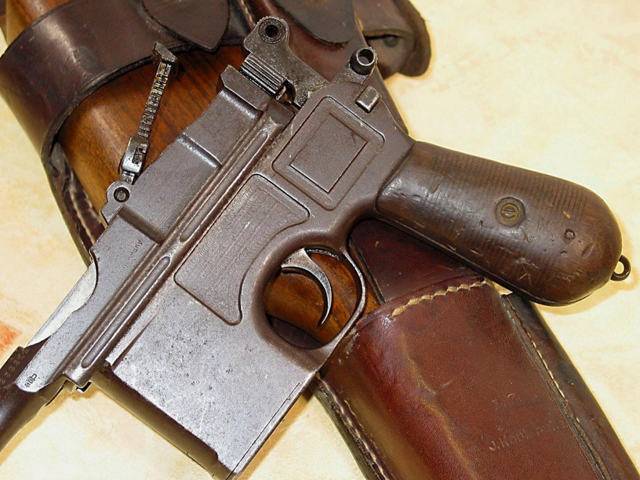
Пистолет Mauser C-96 участвовал во многих войнах, начиная с англо-бурской войны в Южной Африке (1899-1902), в Первой и Второй мировых войнах, в гражданских войнах в России и Испании (в последнем случае использовались в основном копии Маузеров местного производства).
Кроме того, пистолеты Mauser C-96 в межвоенный период закупались Китаем, там же производились и копии знаменитых Маузеров, как в «родном» калибре 7.63мм, так и под американский патрон .45АСР.
Клоны и копии знаменитого пистолета Маузера также выпускались в Испании, под торговыми марками Azul, Royal и Astra.
Одной из отличительных особенностей пистолетов С-96 была их характерная рукоятка, довольно неудобная при стрельбе. Недаром в США этот пистолет прозвали Broomhandle Mauser — “Маузер — рукоятка от метлы».
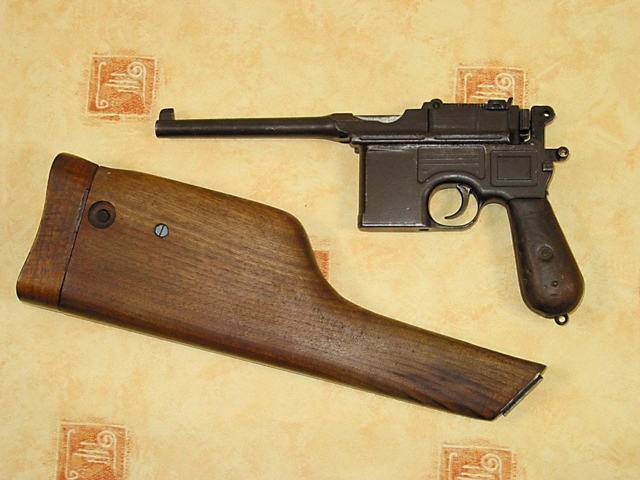
Пистолет Mauser C-96 построен на основе автоматики с коротким ходом ствола и запиранием подствольной боевой личинкой, качающиеся в вертикальной плоскости при взаимодействии с элементами рамки пистолета.
Личинка соединяется с подвижной ствольной коробкой, выполненной зацело со стволом, а внутри нее движется затвор прямоугольного сечения. Двумя зубами на верхней поверхности личинка зацепляет затвор, а при отходе группы ствол-коробка-затвор назад личинка опускается, осовобождая затвор и останавливая ствол.
Магазины коробчатые, расположены перед спусковой скобой, у большинства моделей — фиксированные, вместимостью 10 патронов. Выпускались также варианты с магазинами на 6 или 20 патронов.
Все магазины — двухрядные, с наполнением сверху при открытом затворе, по одному патрону или из специальной обоймы на 10 патронов. Прицельные приспособления — как правило с регулируемым по дальности целиком, размеченным до 1000 метров.
В реальности это был не более чем маркетинговый ход — на дальности в 1000 метров даже в самых лучших условиях разброс попаданий превышал 3 метра. Однако, на дальностях до 150-200 метров Mauser C-96 обеспечивал вполне приемлемую точность стрельбы и убойность, особенно при использовании штатной кобуры-приклада.
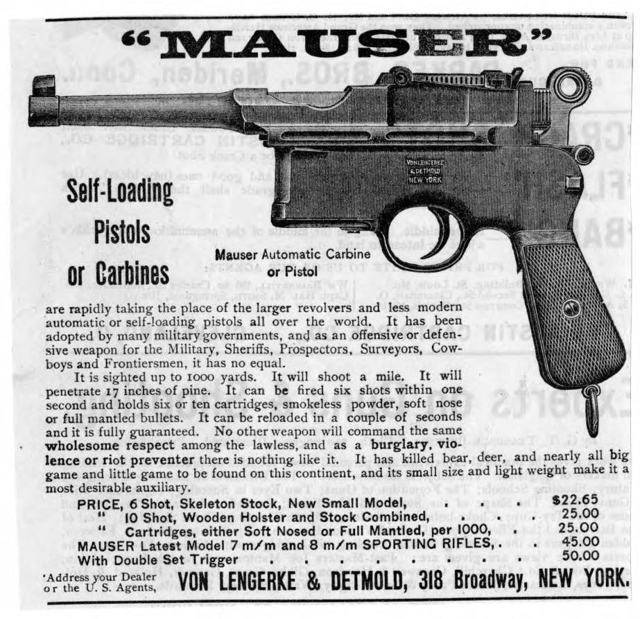
Большинство пистолетов этого типа было выпущено под патрон 7.63х25мм Маузер, в США именовавшемуся “.30 Mauser”. Кроме того, в 1915 году германская армия заказала Маузеры под свой штатный патрон 9мм Парабеллум. Такие пистолеты обозначались большой цифрой «9», вырезанной на щечках рукоятки и залитой красной краской.
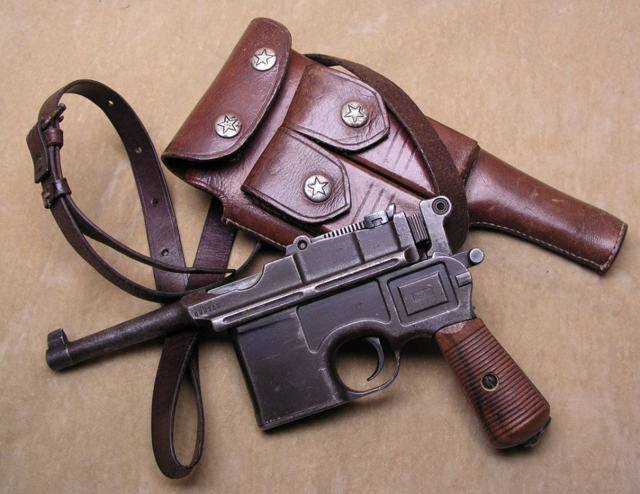
Начиная с 1920 года и до начала 1930х годов в соответствии с ограничениями Версальского договора германские пистолеты Mauser C-96 выпускались с укороченными стволами длиной 99 мм.
Именно такие Маузеры были закуплены Советской Россией в 1920х годах, и этот факт дал повод называть все короткоствольные Маузеры «Боло»-моделями (Боло — от Большевик).
На базе пистолетов также предлагались охотничьи карабины с удлиненным стволом, деревянным цевьем и отъемным прикладом.

References
- Alvarez, José E. (2001). The Betrothed of Death: The Spanish Foreign Legion During the Rif Rebellion, 1920–1927: The Spanish Foreign Legion During the Rif Rebellion, 1920–1927. Westport: Greenwood Press. ISBN .
- Ball, Robert W. D. (2011). Mauser Military Rifles of the World. Iola: Gun Digest Books. ISBN .
- Barnes, Frank C. (2016). Woodard, W. Todd (ed.). Cartridges of the World: A Complete and Illustrated Reference for Over 1500 Cartridges. Iola: Gun Digest Books. ISBN .
- De Haas, Frank; Zwoll, Wayne (2003). Bolt Action Rifles. Iola: Krause Publications. ISBN .
- de Quesada, Alejandro (2014). The Spanish Civil War 1936–39 (1): Nationalist Forces. Oxford: Osprey Publishing. ISBN .
- Hamilton, Douglas T. (1916). “The Military Rifle”. Machinery. New York: The Industrial Press. XXII: 629–637.
- Canales Torres, Carlos; del Rey Vicente, Miguel (2010). de Oyarzába, Graciela; Torres Vitolas, José Luis (eds.). Graciela de Oyarzábal. Breve Historia. Madrid: Ediciones Nowtilus. ISBN 978-84-9763-972-9.
- Peterson, Philip (2017). Standard Catalog of Military Firearms: The Collectors Price & Reference Guide. Iola: Gun Digest Books. ISBN .
- Walter, John (2006). Rifles of the World. Iola: Krause Publications. ISBN .
- Westwood, David (2005). Rifles: An Illustrated History of Their Impact. Santa Barbara: ABC-CLIO. ISBN 978-1851094011.
- Yorulmaz, Naci (2014). Arming the Sultan: German Arms Trade and Personal Diplomacy in the Ottoman Empire. New York: Palgrave Macmillan. ISBN .
History
A combatant during the Spanish Civil War holding a Spanish-made Model 1916 short rifle, a derivative of the Model 1893 rifle
Berbers carrying captured rifles, including a M1893 and a French Berthier carbine
In addition to Mauser, the Spanish 1893 rifles were manufactured under license by a variety of other firms, including Ludwig Loewe & Company (and its successor, Deutsche Waffen und Munitionsfabriken) of Germany, Fabrique Nationale of Belgium, and Fábrica de Armas and Industrias de Guerra de Cataluna of Spain. A total of 206,830 rifles were manufactured in Germany for Spain by 1899, and from 1896 to 1943, Spanish arsenals manufactured more than 2 million of the rifles including all variants. Over the course of Spanish Mauser production, Fábrica de Armas built some 500,000 M1893 rifles at its factory in Oviedo, along with 850,000 M1895s and 325,000 of the modernized Model 1916 rifles.
The 1893 Mauser was used by the Spanish Army in Cuba against US and Cuban insurrectionist forces and in the Philippines against the Philippine Revolutionary Army and US forces during the Spanish–American War in 1898. It gained a deadly reputation particularly from the Battle of San Juan Hill, where only 750 Spanish regulars significantly delayed the advance of 8,500 US troops armed with a mix of outclassed .30–40 and older single-shot, breech-loading Trapdoor Springfield rifles, inflicting 1,400 American casualties. The use of smokeless powder gave the Spanish a major advantage over the single-shot, black powder Springfield that was issued to many United States troops. The Mauser’s 7mm cartridge gave some 300 ft/s (91 m/s) higher velocity and a resultant flatter trajectory over the .30 Army cartridge used in the Krag–Jørgensen rifle. This extended the effective range of Spanish defensive fire. In addition, the higher velocity gave the 7 mm Mauser significantly greater penetrating capability than the .30-40. The M93’s stripper clip system allowed the Spaniards to reload far more quickly than could be done with the Krag, whose magazine had to be loaded one round at a time. A United States Army board of investigation was commissioned as a direct result of this battle. They recommended replacement of the Krag. By 1903, American authorities had adopted the M1903 Springfield, which copied the 1898 Mauser’s bolt and magazine systems, along with a higher-velocity .30 caliber cartridge, the .30-03 (which was later replaced by the more potent .30-06 Springfield).
Spain remained neutral during World War I, but Model 1893 Mausers saw extensive service with both regular troops and the Spanish Legion during the Rif War of 1920–1927 against Moroccan rebels. The rifles were still in service during the Spanish Civil War of 1936–1939 on both sides of the conflict. Many of the Model 1893 rifles were modernized during the war. The 7 mm chambered Mausers were replaced in Spanish service in 1943 by the , a derivative of the German Karabiner 98k, chambered in the more powerful 7.92×57mm Mauser cartridge, though the M1893 and M1916 versions of the rifles remained in service in various capacities into the 1950s. They were still the standard rifle of some Spanish units during the Ifni War, the rifle being also used by their opponents of the Moroccan Army of Liberation. Some of the M1916 guns were modernized in the 1950s and served even longer, though the widespread development of semi-automatic rifles after World War II quickly rendered the Mausers suitable only for second-line duties.
Between 1894 and 1899, Mauser manufactured approximately 201,100 of the M1893 rifles for the Ottoman Empire. The Ottoman Army did not widely issue the rifle to its troops, or indeed train those who were equipped with it. During the Greco-Turkish War of 1897, only about a tenth of Ottoman soldiers were equipped with the rifle, with the remainder carrying obsolescent Snider–Enfields and Martini–Henrys. Many of the M1893s (and other models of modern rifles) acquired by the Ottoman Army were kept in government arsenals rather than issued to soldiers. The same remained true in the Balkan Wars of 1912–1913. Ottoman soldiers, who were typically familiar with old muzzle-loading rifles, frequently had trouble operating the rifle. The rifles continued on in Ottoman service through World War I.
A slightly modified M1893 rifle were also sold to Brazil, chambered in 7 mm and designated M1894. Produced in long rifle and carbine version, it was used during the War of Canudos in 1897 and later during the Contestado War alongside the Mauser Model 1908. Moreover, some M1893 long rifles and cavalry carbines in 7.65 mm were made at Fabrique Nationale for the Belgian Gendarmerie, the Garde Civique and the Congo Free State after 1894.
Description
Illustration of the Model 1893 action
Illustration of the Mauser bolt
The M1893 was manufactured in two variants for Spain, a standard rifle with a 29.06-inch (738 mm) barrel and a short carbine with a 21.75-inch (552 mm) barrel. According to historian John Walter, however, the short version might have been an experimental design only. Both of these variants were chambered in the 7 mm caliber developed by Mauser, and the barrel had 4-groove rifling with a right-hand twist. The rifling was 1 revolution in 8.68 inches (220 mm). The 7 mm ammunition was fired at a muzzle velocity of 2,330 feet per second (710 m/s) from the standard rifle-length barrel. The rifle weighed 8.8 pounds (4.0 kg), while the carbine weighed about 8.3 pounds (3.8 kg). Another variant, built for the Ottoman Army, had the same 29.06-inch barrel as the Spanish rifle, but it was chambered in the slightly larger 7.65×53mm Mauser round. The Ottoman variant weighed about 9 pounds (4.1 kg).
The receiver for all versions of the rifle and the one-piece bolt were forged steel. The receivers had guides for stripper clips milled into the bridge for increased reliability, though the rifles could also be loaded individually. Most bolts featured a straight handle with a rounded grasping knob, though the short rifles were fitted with bolts that had turned down handles. As was standard for Mauser rifles, the M1893 was configured with a three-position safety that locked the action or allowed the bolt to be worked but with a disabled firing pin, in addition to the fire setting. The safety could only be applied while the action was cocked. The bolt was a cock on close design, and locked with a pair of forward locking lugs; unlike later Mauser designs, it did not include a third, rear locking lug, which was introduced with the Model 1895. As a result, the bolt was not as strong as later designs. The M1893 magazine included a bolt stop, which prevented the bolt from being closed on an empty magazine, thus indicating to the soldier that the rifle was empty. To close the bolt with an empty magazine, the follower had to be depressed to clear the bolt stop.
The iron sights included a tangent V-notch rear sight that was graduated from 400 meters (1,300 ft) to 2,000 m (6,600 ft). Later rifles, manufactured from May 1906 onward, received a modernized rear sight, and a third version of the rear sight was adopted in 1913 after an improved 7 mm round, which had the significantly higher muzzle velocity of 2,790 feet per second (850 m/s), was adopted. The barreled receiver was fitted with a wood stock with a . The stock was attached to the barrel with two barrel bands, the forward-most of which also included a bayonet lug for the rifle variant, while the short carbine did not receive the bayonet lug. Each rifle was issued with an M1893 sword bayonet.
Derivatives
In 1894, Mauser designed a new version of the rifle, designated the Model 1894, chambered in 6.5×55mm for the Swedish Army. Further alterations of the basic M1893 design produced the Model 1895, which was chambered in 7 mm and sold in large quantities to Central and South American countries, including Chile, El Salvador, Honduras, Uruguay, and Mexico. The M1895 was also sold to China, Luxembourg, and Persia. Spain also acquired a variant of the M1895 that was essentially identical to the M1893 series with the exception of its 17.5-inch (440 mm) barrel.
The design was refined further into the Model 1896, which was sold to Sweden and the Boer states, the latter placed into very effective use during the Second Boer War of 1899–1902. The Mauser action was further refined in 1898 with the version that was adopted in Germany as the Gewehr 98, which proved to be the most influential of all bolt-action rifles of its time, leading to various military rifles like the German Kar98k, Czech vz. 24, and the Yugoslav M24 series. The 98 action is still copied in modern, commercial hunting rifle designs.
Development
In 1887, the Spanish Army began trials of the Turkish Model 1887 Mauser rifles, which utilized black powder cartridges. These rifles did not satisfy the Spanish Army, and so on 2 December 1891, the Army ordered 1,200 Model 1891 Mausers that used new smokeless powder ammunition. The impetus for the change was a series of defeats of Spanish forces around the enclave at Melilla in North Africa. Trials with these guns provided a series of improvement suggestions for Mauser; in addition to Spanish experiences, by that time, the 1889, 1890, and 1891 series of Mauser rifles had been in service with various armies long enough to highlight deficiencies in the designs. Among the issues that had been identified were an unreliable extractor, a detachable box magazine that was frequently lost and extended below the bottom of the stock, which caused problems with carrying the rifle slung. The stripper clip guide and the clips themselves were also unreliable and the bolt design allowed the rifle to double-feed rounds of ammunition. As a result, Paul Mauser decided to design a new rifle that would correct the problems with the earlier rifles, and allow the company to secure more arms contracts.
The Mauser M1892
Mauser’s design work produced the Model 1892, a transitional design that was manufactured in limited numbers for the Spanish Army. Between 5,000 and 8,000 of the rifles were built for Spain. At the same time, Mauser developed the 7×57mm Mauser cartridge for the Spanish Army, which adopted the round the following year for the M1892 rifles. The M1892 rifle introduced a number of innovations to remedy the problems of the earlier rifles, including the large non-rotating claw extractor on the bolt, which prevented double-feeds. The magazine box and trigger guard were machined as a single piece, preventing the box from being removed and lost, though the magazine was still a single-stack design that extended below the bottom of the stock. The stripper clips and the clip guides were improved to make them easier to use. Other internal changes were made to simplify the action and increase its reliability and safety, including alterations to the sear to prevent it from releasing the firing pin if the bolt was not fully in battery.
Spain placed an order for 20,000 of the M1892 rifles on 21 July 1893, with a further 10,000 added on 27 August, but the design quickly led to an improved version, the Model 1893, which replaced the M1892s ordered. The new version incorporated a staggered 5-round magazine that did not extend below the bottom of the stock. This was the first time a Mauser rifle included a fully contained magazine. Apart from a redesigned receiver to fit the wider magazine, the action of the M1893 was essentially identical to the M1892. The Spanish Army adopted the M1893 on 7 December 1893. For his work in developing such an effective rifle, Mauser received the Grand Cross of the Order of Military Merit from the Spanish government.


